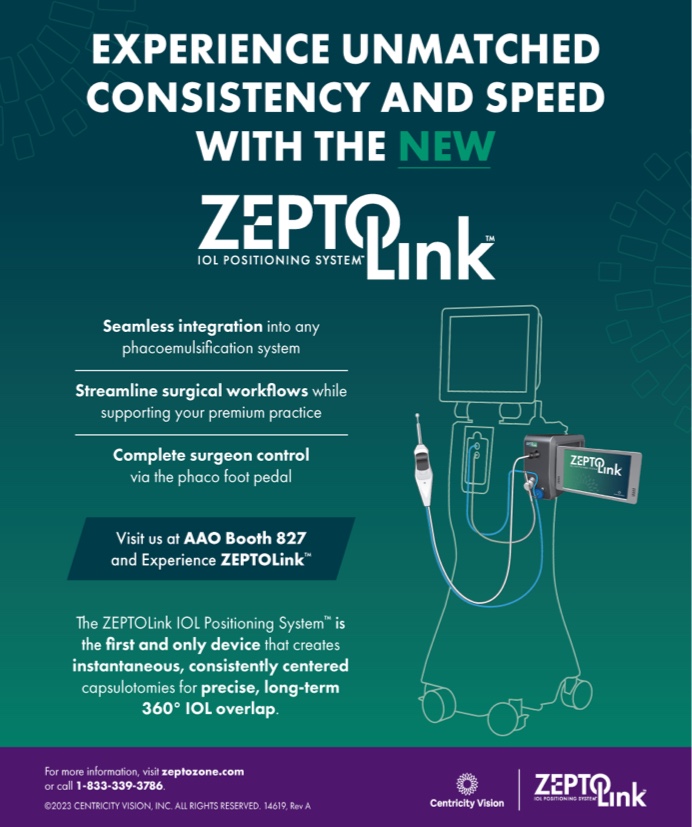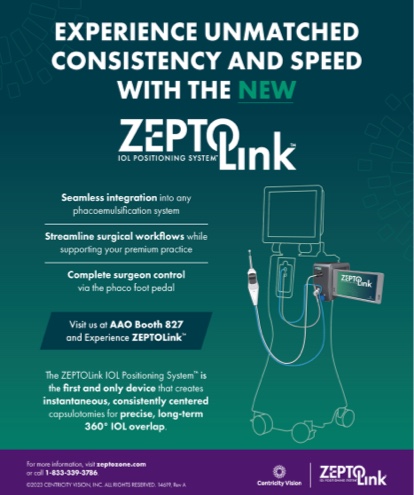Dr. Osher is Editor of the Video Journal of Cataract and Refractive Surgery. Every year, he chairs the "What's New" symposium in New York City and the "Cutting Edge" symposium at the AAO Annual Meeting. As 2007 came to a close, Cataract & Refractive Surgery Today Europe invited Dr. Osher to review the top new products of the year. This article presents his evaluation.
CATEGORY 1: MICROSCOPES
The OPMI Lumera microscope from Carl Zeiss Meditec AG (Jena, Germany) is extraordinary. The resolution is unprecedented, and the depth of field is dramatic. The stereo coaxial illumination provides a brilliant homogeneous red reflex during the capsulorhexis, I/A, the lens' implantation, and the ophthalmic viscosurgical device's (OVD) removal. I would award the Lumera the title of top innovation of the year.
CATEGORY 2: PHACO MACHINES
Both Advanced Medical Optics, Inc. (Santa Ana, CA), and Bausch & Lomb (Rochester, NY) introduced new machines in 2007. The Whitestar Signature System (Advanced Medical Optics, Inc.) features elliptical transverse emulsification, which is in response to the success that Alcon Laboratories, Inc. (Fort Worth, TX), has had with torsional ultrasound. The Stellaris Vision Enhancement System (Bausch & Lomb) has been designed for the transition to sub-2-mm surgery and is compatible with the Akreos lenses (not available in the US; Bausch & Lomb). The wireless foot switch and the option to select either a peristaltic or Venturi pump on the fly are significant innovations.
CATEGORY 3: PHACO TIPS
Two new phaco tips gained attention this past year. The Dewey Radius tip from MicroSurgical Technology (Redmond, WA) has a blunt edge and reportedly offers additional capsular protection. The Osher tip from Alcon Laboratories, Inc., is designed for the surgeon who wants to perform torsional ultrasound but is uncomfortable with the more extreme curve of the Kelman tip. My tip (no financial interest) has a gentle curve, with the bevel opening on the same side as the curve. Takayuki Akahoshi, MD, of Tokyo also independently developed a similar tip. Since 70 of phaco surgeons worldwide prefer a straight tip, this tip should facilitate the transition to torsional ultrasound. The award-winning film from Teruyuki Miyoshi, MD, of Fukuyama, Japan, clearly demonstrates the enhanced efficiency of torsional ultrasound.
CATEGORY 4: IOL INJECTORS
The winner in this category was the Isert Injector from Hoya (not available in the US; Frankfurt, Germany). The lens, preloaded on the reusable injector, never comes into contact with handling instruments or the environment outside the eye. The award-winning film from Hiroko Bissen-Miyajima, MD, of Tokyo emphasizes that the ocular surface is often contaminated during cataract surgery.
CATEGORY 5: IOLs
In the US, Alcon Laboratories, Inc., has swept this category with its introduction of the aspheric AcrySof Restor and the AcrySof Toric lenses. The improved resolution and reduction of the glare circle are impressive on the optical bench. Because the lens can be injected through a 2.2-mm incision, the surgeon does not induce undesirable astigmatism, according to the work of Samuel Masket, MD, of Los Angeles. However, it fails to correct preexisting cylinder, and my European colleagues are fortunate to have the multifocal toric IOLs from Carl Zeiss Meditec AG (which purchased Acri.Tec GmbH) and Rayner Intraocular Lenses, Ltd. (East Sussex, United Kingdom) (both IOLs not available in the US). Refractive cataract surgeons have enthusiastically embraced the introduction of the toric lens, even though the method of identifying the steepest axis leaves room for improvement. Eyeonics, Inc. (Aliso Viejo, CA), with its new Crystalens 5-O, and Visiogen, Inc. (Irvine, CA), with its dual-optic Synchrony (not available in the US), continue to attract an enthusiastic following.
CATEGORY 6: DEVICES
The modification of the Morcher capsular tension ring (CTR; Morcher GmbH, Stuttgart, Germany) by Bonnie Henderson, MD, of Boston to have eight indentations to facilitate cortical removal demonstrates continued innovation in CTR technology. The Capsular Anchor (Hanita Lenses, Kibbutz Hanita, Israel), designed by Ehud I. Assia, MD, of Kfar Saba, Israel, is also exciting. Unfortunately, it may take years for the FDA to approve these products. In 1993, my younger associate, Robert J. Cionni, MD, of Cincinnati and I implanted the first CTRs in the US; it required 11 years before the standard CTR was approved. The other device that created excitement at the 2007 AAO Annual Meeting in New Orleans was the Malyugin ring and inserter (MicroSurgical Technology) for the management of small pupils.
CATEGORY 7: OVDs
As part of the settlement in the lawsuit with Alcon Laboratories, Inc., Advanced Medical Optics, Inc., gained the right to package and market a combination of OVDs. Years prior to the introduction of DuoVisc (Alcon Laboratories, Inc.), I had suggested this idea to Hakan Edstrom, President of the US division of Kabi Pharmacia (Upsala, Sweden). The concept was vetoed in Sweden, and the rest of the story is history. Advanced Medical Optics, Inc., plans to add Healon D, a new dispersive agent, to its existing family of Healon, Healon GV, and Healon5. It is anticipated that the surgeon will be able to select two OVDs in separate carpules for any given case.
CATEGORY 8: SURGICAL KNIVES
Becton, Dickinson and Company (Franklin Lakes, NJ) has set the new standard in blade safety. With increasing concerns about spreading HIV, hepatitis, prion disease, etc., surgeons and OR personnel have rapidly accepted the protective safety shield placed on an assortment of ophthalmic surgical knives.
CATEGORY 9: INSTRUMENTS
Every surgeon has encountered a case in which intraocular scissors or forceps function poorly, because the angle of the blades seems to be in the wrong plane or meridian. For this reason, I designed a unique set of intraocular scissors and forceps with interchangeable tips (no financial interest in the products) with Geuder AG (Heidelberg, Germany) and with Duckworth & Kent, Ltd. (Hertfordshire, United Kingdom) and Bausch & Lomb (Rochester, NY). Compatible with microincisional surgery, the blades have been angled to cut either a vertical or a horizontal plane along different meridia.
Two additional instruments have created much interest. Bong-Hyun Kim, MD, of South Korea has developed an intraocular mirror that allows the surgeon to visualize structures in the angle and in the posterior chamber. Manfred R. Tetz, MD, of Berlin has developed a new device for measuring the anterior chamber diameter and another device for separating the arms of the Artisan and Artiflex (Ophtec, Groningen, the Netherlands; marketed as the Verisyse and Veriflex [Advanced Medical Optics, Inc.] in the US) haptic for easier implantation.
CATEGORY 10: BUGS and DRUGS
Advanced Vision Care (Woburn, MA) has introduced SteriLid, an antiseptic foam that kills 99 of all bacteria within 1 minute of contact. Two antibiotics drew a great deal of attention at the recent AAO Annual Meeting: AzaSite from Inspire Pharmaceuticals, Inc. (Durham, NC), and Iquix from Vistakon Pharmaceuticals, LLC (Jacksonville, FL). AzaSite is 1 azithromycin, a broad-spectrum topical agent with a dosing regimen of twice a day for the first 2 days and once daily thereafter. Iquix is unpreserved 1.5 levofloxacin, the highest available concentration for a topical fluoroquinolone.
Xibrom, produced by Ista Pharmaceuticals (Irvine, CA), completed its phase 3 FDA clinical trials for a higher-concentration, once-daily formulation of this potent anti-inflammatory agent. As interest in intracameral antibiotics continues to grow, the strong safety performance of moxifloxacin created excitement at the AAO Annual Meeting.1
To conclude, 2007 has been a banner year for new products in cataract surgery. Our specialty is predicting continued innovations in 2008.
This article is reprinted with permission from Cataract & Refractive Surgery Today Europe's January/February 2008 edition.
Robert H. Osher, MD, is Medical Director Emeritus at the Cincinnati Eye Institute and Professor at the University of Cincinnati College of Medicine in Ohio. He is a consultant to Alcon Laboratories, Inc., Advanced Medical Optics, Inc., Bausch & Lomb, and Carl Zeiss Meditec, Inc. Dr. Osher may be reached at (513) 984-5133 ext. 3239; rhosher@cincinnatieye.com.


